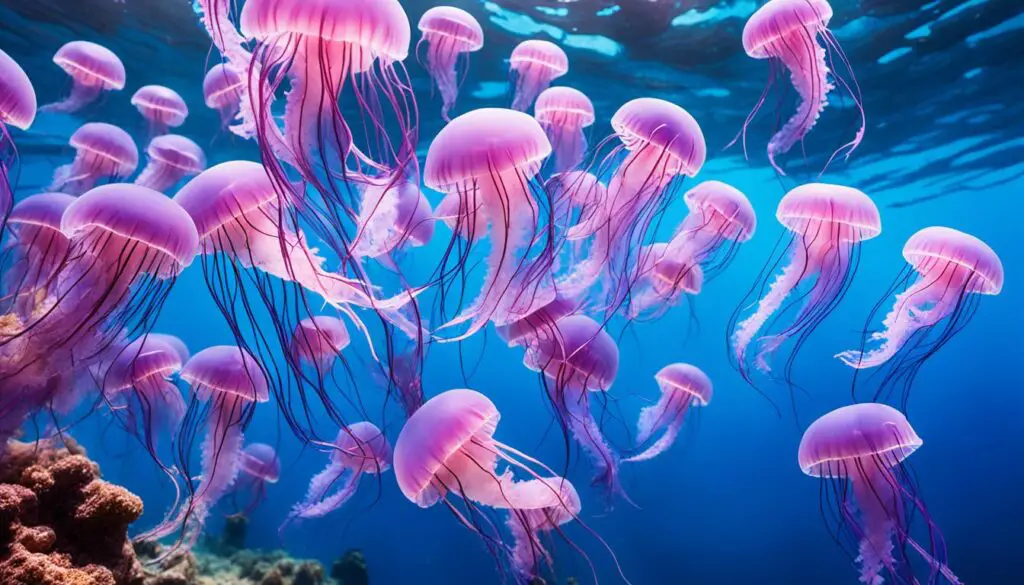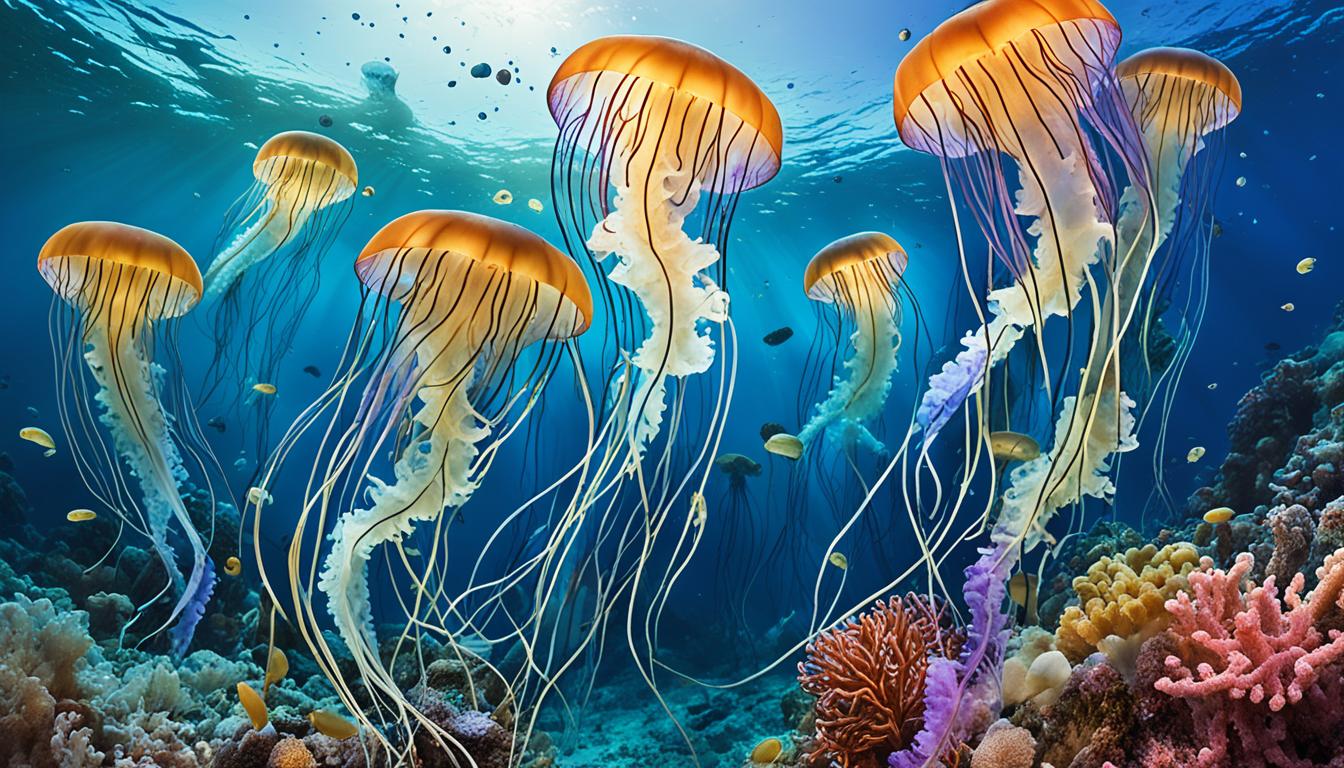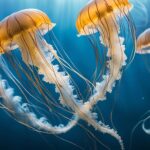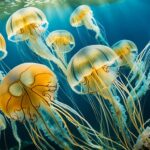Jellyfish have a big impact on our oceans, even though they’re often ignored. These ancient creatures, over 600 million years old, are key to marine life. They are mostly water, making up 95% of their body, and play a big role in controlling food chains and recycling nutrients.
Studies show that jellyfish affect fish populations and help with carbon capture in their life cycles. This section will look at how jellyfish shape ecosystems. We’ll see how they keep the ocean healthy and balanced.
Understanding the Ecological Role of Jellyfish
Jellyfish are key players in marine ecosystems. They help keep the balance in many habitats. Their actions greatly affect the complex relationships in marine food chains. This includes how predators and prey interact and the overall health of the ecosystem.
Jellyfish as Keystone Species in Marine Food Webs
Jellyfish eat phytoplankton and small zooplankton, which is important for nutrient cycling. This helps control their own numbers and boosts energy flow in marine food webs. They also create safe spaces for young fish, giving them a place to live and find food.
Their presence changes the mix of species in an area. This shows how big their impact is on marine life.
Interaction with Predators and Competition
Jellyfish, their predators, and other species compete for resources. Big fish eat jellyfish, but jellyfish can also harm fish by eating their young. This shows how jellyfish affect the balance in ecosystems.
How do jellyfish affect ecosystems?
Jellyfish are key players in marine ecosystems. They impact many biological processes and how different species interact. Their presence affects fish populations and helps young fish grow. This shows how important they are to the ecosystem.
Influence on Fish Populations and Larval Habitats
Jellyfish help fish populations by offering jellyfish larval habitats. These places protect young fish from predators and help them find food. The link between fish and jellyfish is good for both, especially in areas where fish are scarce.
This relationship helps fish recover by giving them a safe place to grow and eat. Jellyfish help more young fish survive and grow, which is good for the fish population.
Nutrient Cycling and Organic Matter Contribution
Jellyfish play a big part in jellyfish nutrient cycling. They release important nutrients through their waste and when they die. This helps change the ocean’s microbial communities.
When jellyfish sink to the ocean floor, they add organic matter to the sediment. This supports life on the ocean floor. It also makes nutrients available to phytoplankton and other plants, which are the base of the ocean’s food web.
This process shows how jellyfish affect marine nutrient dynamics. They help keep the ocean healthy by cycling nutrients and adding organic matter.

Jellyfish Blooms and Their Consequences for Marine Ecosystems
Jellyfish blooms happen when their numbers grow fast, affecting marine ecosystems a lot. Many environmental factors make them increase in size.
Definition and Causes of Jellyfish Blooms
Jellyfish blooms are often caused by both human and natural factors. Some main reasons include:
- Overfishing: Fewer natural predators let jellyfish grow more.
- Nutrient runoff: Runoff from farms adds too many nutrients to the sea, helping jellyfish.
- Climate change: Changes in ocean conditions make it better for jellyfish.
Environmental Impact of Large Jellyfish Population Surges
Jellyfish blooms have big effects on marine life. These effects include:
- Less fish because jellyfish eat fish eggs and young fish.
- Less food for other sea creatures because jellyfish take it all.
- Changes in who lives in the ocean, hurting biodiversity.
As jellyfish blooms get bigger and more common, we need to understand their effects. This will help us manage them better. We need more research to deal with these issues.
| Cause of Jellyfish Blooms | Description |
|---|---|
| Overfishing | Reduction of predators leading to increased jellyfish survival rates. |
| Nutrient Runoff | Elevated nutrient levels from land-based runoff fueling jellyfish growth. |
| Climate Change | Rising water temperatures creating optimal breeding conditions for jellyfish. |
Jellyfish as Indicators of Ocean Health
Studying jellyfish helps us understand ocean health. As jellyfish numbers grow, they show us changes in marine life. They are key to tracking how climate change affects the ocean.
Jellyfish Proliferation and Climate Change Correlations
More jellyfish mean climate change is having a big impact. Warmer waters and changes in salt levels help jellyfish thrive. This leads to more blooms, showing ocean health is changing.
How Jellyfish Serve as Bioindicators in Marine Studies
Jellyfish are important for marine research. They tell us about the ocean’s conditions. By watching jellyfish, scientists can check on ecosystem health and see how human actions affect the sea.
| Aspect | Jellyfish Proliferation | Environmental Health Indicators |
|---|---|---|
| Temperature Sensitivity | Often thrive in warmer waters | Potential indicator of rising ocean temperatures |
| Nutrient Availability | Increased populations with high nutrient runoff | Indicates eutrophication in marine environments |
| Food Web Impact | Can alter the abundance of fish species | Reflects disruptions in marine food chains |
| Human Influence | Population surges linked to overfishing | Demonstrate effects of anthropogenic stressors |
The Importance of Biodiversity Implications
Understanding how jellyfish affect marine ecosystems is key to keeping them healthy. These creatures play a big role in keeping the ocean balanced. They do this by controlling the number of other animals and providing homes for many species. This helps keep the ocean stable and productive.
Studies show that jellyfish help with nutrient cycling, which benefits other sea creatures. They are crucial for the survival of many marine species. But, the rise in jellyfish numbers worries scientists. This is because climate change and overfishing are changing the ocean’s conditions.
We need to think about how to manage the growth of jellyfish. Finding a balance between jellyfish and other sea life is important. This balance will help these ecosystems stay strong. It will also protect our oceans and keep them healthy for the future.










